|
 |
|
Lawrence M. Witmer,
PhD
Professor of Anatomy
Chang Professor of Paleontology
Dept. of Biomedical Sciences
Heritage
College of Osteopathic Medicine
Life Science Building, Rm 123
Ohio University
Athens, Ohio 45701 USA
Email:
witmerL@ohio.edu
|
|
|
|








 |
|
|
|
| |
 |
Breathing life into dinosaurs — modeling nasal airflow in
pachycephalosaurid dinosaurs |
 |
|
|
Common Language Summary
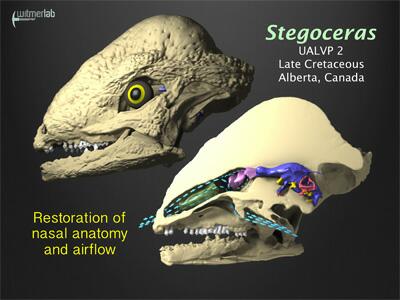
3D
modeling of airflow sheds new light on dinosaur smelling and
physiology. Technology, engineering, and anatomy provide
the first ever glimpse into how air moves through the head of a
breathing dinosaur. A team of researchers lead by an Ohio
University doctoral student capitalized on the discovery of
extraordinary preservation of soft tissues within the nasal
cavities of dinosaurs, leading to new findings about not just
breathing, but also brain cooling and the sense of smell. The
Cretaceous “bone-headed” pachycephalosaurid dinosaurs were small
herbivores known for thick bony skulls. Building all that bone
had the by-product of ossifying delicate nasal tissues that
usually don’t fossilize. CT scanning the fossils of a Canadian
“pachy” called Stegoceras revealed these internal structures in
unprecedented detail, including scrolled olfactory “turbinates”
in the back of the nose and a long bony ridge in the front. By
adapting techniques from a branch of engineering called
computational fluid dynamics, the team was able to simulate
airflow during breathing and test different turbinate
shapes. The simulations revealed that for realistic
airflow to take place, the bony ridge must have supported a
respiratory turbinate in the front of the nasal cavity that
helped to direct inspired air to the olfactory region in the
back, directly adjacent to the part of the brain that processes
odor information. The idea of respiratory turbinates as baffles
to direct air around the nasal cavity had never been suggested
for dinosaurs. Moreover, the team discovered patterns of blood
flow in the nasal region of Stegoceras that indicate that the
turbinates also likely functioned to cool blood destined for the
brain, allowing these animals to moderate brain temperatures in
times of heat stress. Armed with these new techniques, the team
will now tackle other more complicated dinosaur noses, such as
those of ankylosaurs and hadrosaurs. |
|
|
|
Graphics & Animations |
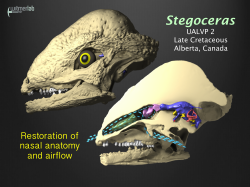
Airflow
modeled through the nasal cavity of the Cretaceous
pachycephalosaur Stegoceras based on restoration of nasal
soft tissues and Computation Fluid Dynamics of nasal airflow.
This is the first study to analytically model nasal airflow in
any extinct animal. A very general key finding was that
comparative anatomy can be combined with engineering to restore
the nasal physiology of extinct species. Courtesy of WitmerLab
at Ohio University.
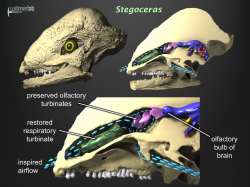
Airflow
modeled through the nasal cavity of the Cretaceous
pachycephalosaur Stegoceras based on restoration of a
respiratory turbinate onto a long bony ridge preserved in the
fossil. Simulations using computational fluid dynamics software
revealed that a turbinate of at least broadly similar shape must
have been present to act as a baffle to allow realistic airflow
to the olfactory region. Courtesy of WitmerLab at Ohio
University.
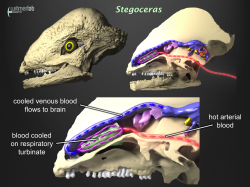
Restoration of blood flow through the nasal
cavity of the Cretaceous pachycephalosaur Stegoceras. The
restored respiratory turbinate increased the surface area of the
nasal tissues. Hot arterial blood coming from the body core
would have been cooled by evaporation on the respiratory
turbinate, and the cooled venous blood would have then flowed to
the brain region to moderate brain temperatures. Courtesy of
WitmerLab at Ohio University.
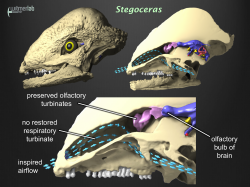
Airflow
modeled through the nasal cavity of the Cretaceous
pachycephalosaur Stegoceras in the absence of restoration
of a respiratory turbinate. The fossil itself only preserves a
bony ridge, not the respiratory turbinate itself. Simulations
using computational fluid dynamics software revealed that,
taking the fossil at “face value,” absence of the turbinate
produces unrealistic airflow patterns in that almost no inspired
air reaches the olfactory region. Courtesy of WitmerLab at Ohio
University. 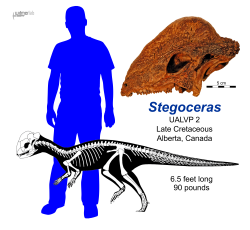
Skeleton of
the Cretaceous pachycephalosaur Stegoceras with the
silhouette of a human for scale. The original skull of
Stegoceras is shown at top right. Skeleton and silhouette
provided by C. Brown, Royal Tyrrell Museum of Palaeontology;
photo of skull provided by P. Currie, University of Alberta.
Courtesy of WitmerLab at Ohio University.
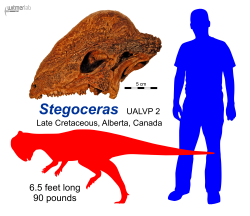
Silhouettes of the Cretaceous pachycephalosaur Stegoceras in head-butting posture and of a human, for scale. The original skull of Stegoceras is shown at top left. Silhouettes provided by C. Brown, Royal Tyrrell Museum of Palaeontology; photo of skull provided by P. Currie, University of Alberta. Courtesy of WitmerLab at Ohio University.
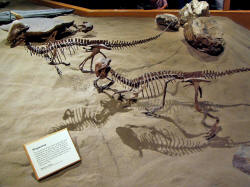
Mounted
skeletons two Stegoceras in the gallery at the Royal
Tyrrell Museum of Palaeontology in Drumheller, Alberta. Photo by
S. Bergmann, Wikipedia. |
|
|
|
Animation of simulated airflow in the Cretaceous pachycephalosaurid dinosaur Stegoceras (UALVP 2) based on different models of restored nasal soft tissues. In the absence of any restored soft tissues, modeled airflow bypasses the olfactory region, which is not realistic. By modeling a respiratory turbinate (in this case, an ostrich-like branched concha) attaching to the preserved bony ridge, realistic olfactory airflow is modeled. It's also likely that the nasal structures functioned to cool blood that was destined for the brain region. This is largely the work of Jason Bourke (Ohio University) to accompany an article published in the Anatomical Record (2014) by Bourke, Porter, Ridgely, Lyson, Schachner, Bell, and Witmer. Research supported in part by the NSF-funded Visible Interactive Dinosaur project, WitmerLab at Ohio University.
• Download a 43 MB QuickTime version (HD: 1920x1080)
• Download a 24 MB QuickTime version (1280x720)
• Download a 14 MB QuickTime version (853x480)
• Download a 10 MB QuickTime version (640x360) |
|
|
|
|
|
Animation of simulated airflow in the Cretaceous pachycephalosaurid dinosaur Stegoceras (UALVP 2) based on different models of restored nasal soft tissues. This video is largely the work of Jason Bourke (Ohio University) and is an AR WOW video (http://bcove.me/k1si0ck1) to accompany an article published in the Anatomical Record (2014) by Bourke, Porter, Ridgely, Lyson, Schachner, Bell, and Witmer. Research supported in part by the NSF-funded Visible Interactive Dinosaur project, WitmerLab at Ohio University.
• Download a 102 MB QuickTime version (HD: 1920x1080)
• Download a 58 MB QuickTime version (1280x720)
• Download a 28 MB QuickTime version (853x480)
• Download a 19 MB QuickTime version (640x360) |
|
|
|
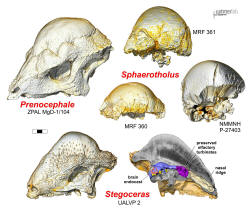 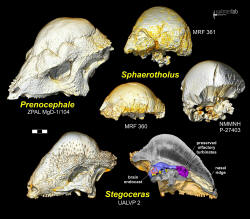
Skulls of pachycephalosaurid dinosaurs discussed in the scientific article, based on volume-rendered CT scan data. The three Sphaerotholus specimens are missing the facial part of the skull. Scale bar is 3 cm. Courtesy of WitmerLab at Ohio University. |
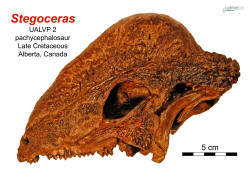
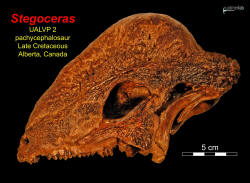
The original skull of Stegoceras. Photo of skull provided by P. Currie, University of Alberta. Courtesy of WitmerLab at Ohio University. |
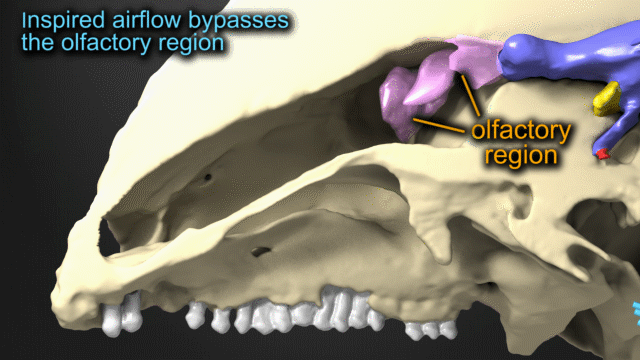
Animated GIF:
Airflow
modeled through the nasal cavity of the Cretaceous
pachycephalosaur Stegoceras in the absence of restoration of a respiratory turbinate. Courtesy of WitmerLab at Ohio University.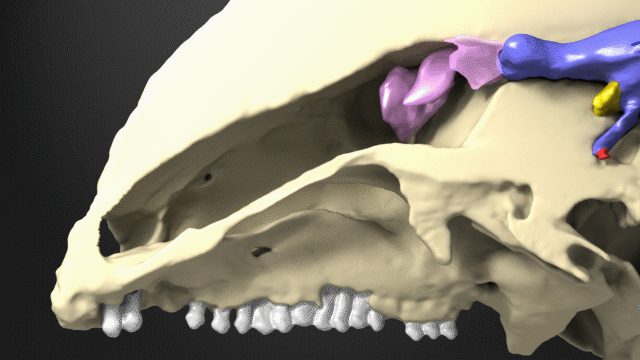
Animated GIF: Restored respiratory turbinate moving into place to attach to the long internal nasal ridge preserved in the fossil. Courtesy of WitmerLab at Ohio University.

|
| Animated GIF: Airflow modeled through the nasal cavity of the Cretaceous pachycephalosaur Stegoceras based on restoration of nasal soft tissues and Computation Fluid Dynamics of nasal airflow. Courtesy of WitmerLab at Ohio University. 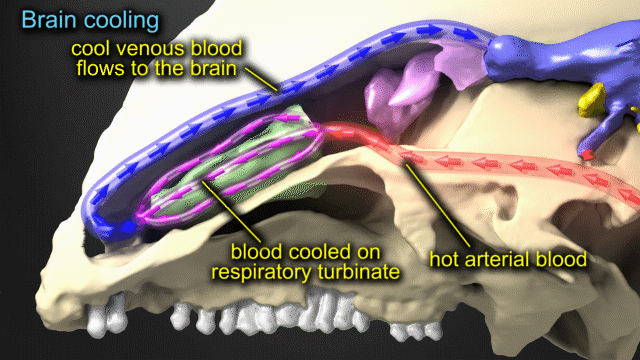
Animated GIF:
Restoration of blood flow through the nasal
cavity of the Cretaceous pachycephalosaur Stegoceras. Courtesy of WitmerLab at Ohio University.
|
|
|
|
Ohio University News Release |
|
EMBARGOED FOR
RELEASE TUESDAY, 14 OCT 2014, 4:00 PM EDT
Dinosaur
breathing study shows that noses enhanced smelling and cooled
brain
Researchers discover preserved
nasal features in bony-headed dinosaur fossils
ATHENS, Ohio (Oct. 14, 2014)—It’s
been millions of years since T. rex took its last breath,
but a team led by Ohio University scientists is breathing life
back into dinosaurs using high-powered computer simulations to
model airflow through dinosaur snouts. The research has
important implications for how dinosaurs used their noses to not
only breathe but to enhance the sense of smell and cool their
brains.
“Dinosaurs were pretty ‘nosy’ animals,” said Ohio University
doctoral student Jason Bourke, lead author of the new study
published today in the Anatomical Record. “Figuring out
what’s going on in their complicated snouts is challenging
because noses have so many different functions. And it doesn’t
help that all the delicate soft tissues rotted away millions of
years ago.”
To restore what time had stripped away, the team turned to the
modern-day relatives of dinosaurs—birds, crocodiles and
lizards—to provide clues. “We’ll do whatever it takes,” said
Lawrence Witmer, professor in the Ohio University Heritage
College of Osteopathic Medicine and principal investigator on
the National Science Foundation’s Visible Interactive Dinosaur
Project, which funded much of the research. “We did lots of
dissections, blood-vessel injections and CT scanning, but a
major new tool was 3D computer simulation of airflow.”
Bourke drew from a branch of engineering called computational
fluid dynamics, an approach commonly used in the aerospace
industry and medicine, to model how air flowed through the noses
of modern-day dinosaur relatives such as ostriches and
alligators. “Once we got a handle on how animals today breathe,”
Bourke said, “the tricky part was finding a good candidate among
dinosaurs to test our methods.”
The dinosaurs that best fit the bill were the pachycephalosaurs,
or “pachys,” a group of plant-eating dinosaurs best known for
the several-inch-thick bone on the tops of their skulls which is
thought to have served both as a visual display and as
protection for head-butting behaviors like those of modern-day
rams. It turns out that building all that extra skull bone
resulted in ossifying soft tissues in other areas of the
body—such as the nose.
“When we cleaned up the fossil skull of Sphaerotholus, a
pachy from North Dakota, we didn’t expect to see these delicate
scrolls of bone in the nasal region. We knew they must be nasal
turbinates,” said Emma Schachner, a co-author on the study from
Louisiana State University who, along with Tyler Lyson of the
Denver Museum of Nature and Science, studied some of the fossil
specimens used in the study. Similar structures were found in a
different pachy species from Canada called Stegoceras by
co-author Phil Bell from the University of New England in
Australia.
The first nasal turbinates to be discovered were in the back
part of the nasal cavity, called the olfactory chamber, where
smelling takes place. Work by Witmer and Ohio University
researcher Ryan Ridgely on CT scans of Stegoceras showed
that the olfactory region of the brain was quite large, which,
along with the large olfactory turbinates, suggested that
Stegoceras had a good sense of smell.
But when Bourke ran his airflow simulation analyses, the
inspired air bypassed the olfactory chamber. “It made no sense,”
Bourke said. “Stegoceras obviously had a pretty decent
sense of smell, but the odors weren’t reaching where they needed
to go. We obviously were missing a piece of the puzzle.”
That missing puzzle piece was hinted at by a long bony ridge on
the wall of the front of the nasal cavity. In the modern-day
relatives of dinosaurs, cartilaginous nasal turbinates often
attach to such ridges, suggesting to the team that pachys may
have had turbinates in the front, respiratory part of the nasal
cavity.
When Bourke digitally inserted respiratory turbinates of
different shapes—whether it was the scrolled turbinate of a
turkey or the branched turbinate of an ostrich—the computer
airflow simulations started to make more sense.
“Some of the restored airflow patterns now carried odors to the
olfactory region,” said Bourke. “We don’t really know what the
exact shape of the respiratory turbinate was in Stegoceras,
but we know some kind of baffle had to be there. We have the
smoking gun of the bony ridge on the fossil, and the airflow
analyses show that attaching some kind of turbinate produced the
only airflow that made any real biological sense.”
Why have turbinates at all? Some scientists had previously
suggested that warm-blooded animals such as birds and mammals
have turbinates to act like condensers to save water that might
have been lost during exhalation. That may be true in some
cases, but this new research suggests that turbinates also have
important functions as baffles to direct air to the olfactory
region. But they might also play another critical role—cooling
the brain.
Study co-author Ruger Porter, another Ohio University doctoral
student, has been studying the pattern of blood flow in
pachycephalosaurs and other dinosaurs, as well as their
modern-day relatives. “The fossil evidence suggests that
Stegoceras was basically similar to an ostrich or an
alligator,” Porter said. “Hot arterial blood from the body was
cooled as it passed over the respiratory turbinates, and then
that cooled venous blood returned to the brain. It may not have
been much of a brain, but you don’t want it cooked!”
Now that Bourke and his team have worked out nasal airflow in
the “easy case” of Stegoceras, the team is turning its attention
to trickier dinosaur cases, such the crazy-straw airways of
armored ankylosaurs and duckbilled hadrosaurs.
The research was funded by National Science Foundation grants to
Witmer and Ridgely and a fellowship to Bourke, as well as by the
Ohio University Heritage College of Osteopathic Medicine.
Editors:
• Related images and animations can be downloaded from the
WitmerLab site:
pachy_airflow.htm
• A fact sheet can be accessed here:
Downloads/dinosaur_breathing_facts_and_graphics.pdf
Contacts (all Eastern Daylight Time):
1. Jason Bourke, 740-818-7503,
jb513009@ohio.edu
[lead author]
2. Lawrence Witmer, 740-591-7712,
witmerL@ohio.edu
[co-author]
3. Andrea Gibson, 740-597-2166,
gibsona@ohio.edu
[Director of Research Communications]
|
|
|
 |
This website provides supplementary information as an
adjunct to the published paper. Witmer, with the skilled
assistance of
Ryan Ridgely, is responsible for
the content of the website. Content provided here is for
educational and research purposes only, and may not be used for
any commercial purpose without the permission of
L. M. Witmer and other
relevant parties.
This project was funded by grants from the
National Science
Foundation. |
|
|